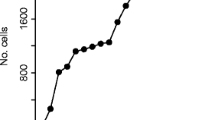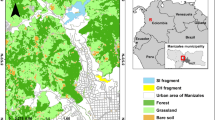Abstract
Anthropogenic habitat alteration can have a dramatic effect on the spatial distribution and ranging patterns of primates. We characterized the spatial ecology of a free-living troop of chacma baboons (Papio ursinus) in a human-modified environment in the Cape Peninsula, South Africa. We used GPS and behavioral observations collected over 1 yr to quantify the troop’s home range size, habitat selection, choice of sleeping site, and foraging patterns. The troop comprised 115 individuals living in a home range of 9.50 km2, giving a density of 12.1 baboons/km2. Area use correlates positively with exotic vegetation and negatively with indigenous vegetation and altitude. The troop spent significantly more time in low-lying human-modified environments, i.e., plantations, vineyards, and urban habitat, than in indigenous vegetation that was largely restricted to steeper slopes at higher elevations. The troop slept exclusively in exotic trees, 94% of which were located in the plantation, 3% in urban habitat, and 3% in vineyards. The most consumed food items were exotic grasses, subterranean food items, and exotic pine nuts. The survival and persistence of the focal troop in close proximity to the urban edge while ≥3 neighboring troops were previously extirpated suggests that access to low-lying land in conjunction with a land-use practice that does not preclude baboon presence has been fundamental to both their survival and persistence at such a high density. The almost exclusive use of exotic vegetation both as a food source and as a safe refuge for sleeping highlights the ecological flexibility of baboons, but the systematic loss of low-lying productive land poses the single greatest threat to their continued persistence on the Cape Peninsula.





Similar content being viewed by others
References
Altmann, S. A. (1974). Baboons, space, time and energy. American Journal of Zoology, 14, 221–248.
Altmann, S. A. (1998). Foraging for survival. Yearling baboons in Africa. Chicago: University of Chicago Press.
Altmann, S. A., & Altmann, J. (1970). Baboon ecology: African field research. Chicago: University of Chicago Press.
Altmann, J., & Muruthi, P. (1988). Differences in daily life between semiprovisioned and wild-feeding baboons. American Journal of Primatology, 15, 213–221.
Anderson, J. R. (1984). Ethology and ecology of sleep in monkeys and apes. Advances in the Study of Behavior, 14, 165–229.
Barton, R. A., Whiten, A., Strum, S. C., Byrne, R. W., & Simpson, A. J. (1992). Habitat use and resource availability in baboons. Animal Behaviour, 43, 831–844.
Biryahwaho, B. (2002). Community perspectives towards management of crop raiding animals. Experiences of Care DTC with communities living adjacent to Bwindi Impenetrable and Mgahinga Gorilla Nationgal Parks, southwest Uganda. In C. M. Hill, F. V. Osborne, & A. J. Plumptre (Eds.), Human–wildlife conflict: Identifying the problem and possible solutions. Albertine Rift technical reports series, vol. 1 (pp. 46–57). New York: Wildlife Conservation Society.
Brennan, E. J., Else, J. G., & Altmann, J. (1985). Ecology and behaviour of a pest primate: Vervet monkeys in a tourist-lodge habitat. African Journal of Ecology, 23, 35–44.
Bronikowski, A. M., & Altmann, J. (1996). Foraging in a variable environment, weather patterns and the behavioural ecology of baboons. Behavioral Ecology and Sociobiology, 39, 11–25.
Brown, L. R., Marais, H., Barrett, L., & Henzi, S. P. (2006). Habitat structure, population characteristics and resource utilisation by chacma baboons in commercial forestry areas of the Eastern Mpumalanga Escarpment. A report prepared for Global Forestry Products and Komatiland Forests. pp. 63.
Byrne, R. W., Whiten, A., Henzi, S. P., & McCulloch, F. M. (1993). Nutritional constraints on mountain baboons (Papio ursinus): implications for baboon socioecology. Behavioral Ecology and Sociobiology, 33, 233–246.
Clutton-Brock, T. H. (1977). Some aspects of intra-specific variation in feeding and ranging behaviour in primates. In T. H. Clutton-Brock (Ed.), Primate ecology (pp. 539–556). New York: Academic.
Cowling, R. M., MacDonald, I. A. W., & Simmons, M. T. (1996). The Cape Peninsula, South Africa: physiographical, biological and historical background to an extraordinary hot-spot of biodiversity. Biodiversity and Conservation, 5, 527–550.
DeVore, I., & Hall, K. R. L. (1965). Baboon ecology. In I. DeVore (Ed.), Primate behaviour: Field studies of monkeys and apes (pp. 20–52). New York: Holt, Rinehart and Winston.
Dunbar, R. I. M. (1992). Time, a hidden constraint on the behavioural ecology of baboons. Behavioral Ecology and Sociobiology, 31, 35–49.
Eley, R. M., Strum, S. C., Muchem, G., & Reid, G. D. F. (1989). Nutrition, body condition, activity patterns and parasitism of free ranging troops of olive baboons (Papio anubis) in Kenya. American Journal of Primatology, 18, 209–219.
Else, J. G. (1991). Nonhuman primates as pests. In H. O. Box (Ed.), Primate responses to environmental change (pp. 137–153). London: Chapman and Hall.
Erasmus, D. (1993). Damage by baboons to pine plantations in South Africa, with special reference to the ecology of three troops of baboons in the Western Cape. Dissertation, University of Stellenbosch, Stellenbosch, South Africa.
Forthman Quick, D. L. (1986). Activity budgets and the consumption of human food in two troops of baboons, Papio anubis, at Gilgil, Kenya. In J. Else & P. C. Lee (Eds.), Primate ecology and conservation (pp. 221–228). Cambridge: Cambridge University Press.
Forthman Quick, D. L., & Demment, M. W. (1998). Dynamics of exploitation, differential energetic adaptations of two troops of baboons to recent human contact. In E. C. Fa & H. Southwick (Eds.), Ecology and behaviour of food-enhanced primate groups (pp. 25–52). New York: Alan R. Liss.
Fuentes, A., Southern, M., & Suaryana, K. G. (2005). Monkey forests and human landscapes: Is extensive sympatry sustainable for Homo sapiens and Macaca fascicularis on Bali? In J. D. Patterson & J. Wallis (Eds.), Commensalism and conflict: The human–primate interface (pp. 168–195). Norman: American Society of Primatologists.
Ganas, J., & Robbins, M. M. (2005). Ranging behaviour of the mountain gorillas (Gorilla beringei beringei) in Bwindi Impenetrable National Park, Uganda: A test of the ecological constraints model. Behavioral Ecology and Sociobiology, 58, 277–288.
Hall, K. R. L. (1962). Numerical data, maintenance activities and locomotion in the wild chacma baboon, Papio h. ursinus. Proceedings of the Zoological Society of London, 139, 181–220.
Hall, K. R. L. (1963). Variations in the ecology of the chacma baboon. Symposia of the Zoological Society of London, 10, 1–28.
Hamilton, W. J. I. I. I. (1982). Baboon sleeping site preferences and relationships to grouping patterns. American Journal of Primatology, 3, 41–53.
Hamilton, W. J., & Tilson, R. L. (1982). Solitary male chacma baboons in a desert canyon. American Journal of Zoology, 24, 149–158.
Hamilton, W. J., III, Buskirk, R. E., & Buskirk, W. H. (1976). Defense of space and resources by chacma baboons (Papio h. ursinus) in an African desert and swamp. Ecology, 57, 1264–1272.
Henzi, S. P., & Lycett, J. E. (1995). Population structure, demography, and dynamics of mountain baboons, an interim report. American Journal of Primatology, 35, 155–163.
Henzi, S. P., Byrne, R. W., & Whiten, A. (1992). Patterns of movement by baboons in the Drakensberg Mountains, primary responses to the environment. International Journal of Primatology, 13, 601–629.
Hill, C. M. (2000). Conflict of interest between people and baboons, crop raiding in Uganda. International Journal of Primatology, 21, 299–315.
Hill, C. M. (2005). People, crops, and primates, a conflict of interest. In J. D. Patterson & J. Wallis (Eds.), Commensalism and conflict: The human–primate interface (pp. 40–59). Norman: American Society of Primatologists.
Hill, R. A., Barrett, L., Gaynor, D., Weingrill, T., Dixon, P., & Payne, H. (2003). Day length latitude and behavioural (in)flexibility in baboons (Papio cynocephalus ursinus). Behavioral Ecology and Sociobiology, 53, 278–286.
Hill, R. A., Barrett, L., Gaynor, D., Weingrill, T., Dixon, P., Payne, H., et al. (2004). Day length variation and seasonal analysis of behaviour. South African Journal of Wildlife Research, 34, 39–44.
Jenness, J. (2004). Nearest features (nearfeat.avx) extension for ArcView 3.x, v. 3.8a. Jenness Enterprises. <http://www.jennessent.com/arcview/arcview_extensions.htm>. (Accessed August 16, 2006).
Jenness, J. (2005). Repeating shapes (repeat_shapes.avx) extension for ArcView 3.x. Jenness Enterprises <http://www.jennessent.com/arcview/arcview_extensions.htm>. (Accessed August 16, 2006).
Kansky, R., & Gaynor, D. (2000). Baboon management strategy for the Cape Peninsula. Final Report, Table Mountain Fund Project number ZA 568, Cape Town, South Africa.
Lee, R. J. (1997). The impact of hunting and habitat disturbance on the population dynamics of the crested black macaque (Macaca nigra). Dissertation, University of Oregon, Boulder.
Lee, P. C., Brennan, E. J., Else, J. G., & Altmann, J. (1986). Ecology and behaviour of vervet monkeys in a tourist lodge habitat. In J. G. Else & P. C. Lee (Eds.), Primate ecology and conservation. Selected proceedings of the tenth congress of the International Primatological Society, Vol. 2 (pp. 229–236). New York: Cambridge University Press.
Li, Z., & Rogers, M. E. (2005). Habitat quality and range use of white headed langurs in Fusui, China. Folia Primatologica, 76, 185–195.
Li, Y., Liao, M., Yu, J., & Yang, J. (2005). Effects of annual change in group size, human disturbances and weather on daily travel distance of a group of Sichuan snub-nosed monkey (Rhinopithecus roxellana) in Shennongjia Nature Reserve, China. Biodiversity Science, 13, 432–438.
Mascarenhas, A. (1971). Agricultural vermin in Tanzania. In S. H. Ominde (Ed.), Studies in East African geography and development (pp. 259–267). London: Heinemann Educational Books.
Menard, N., & Vallet, D. (1997). Behavioural responses of barbary macaques (Macaca sylvanus) to variations in environmental conditions in Algeria. American Journal of Primatology, 43, 285–304.
Morris, B. (2000). Wildlife depredations in Malawi, the historical dimension. In J. Knight (Ed.), Natural enemies: People–wildlife conflicts in anthropological perspective (pp. 36–49). London: Routledge.
Naughton-Treves, L. (1996). Uneasy neighbors, wildlife and farmers around Kibale National Park, Uganda. Ph.D. dissertation, University of Florida, Gainesville, FL.
Naughton-Treves, L., Treves, A., Chapman, C., & Wrangham, R. (1998). Temporal patterns of crop-raiding by primates, linking food availability in croplands and adjacent forest. Journal of Applied Ecology, 35, 596–606.
O’Brien, T. G., & Kinnaird, M. F. (1997). Behaviour, diet, and movements of the Sulawesi crested black macaque. International Journal of Primatology, 18, 321–351.
Pepeh, K. (1996). A preliminary assessment of crop damage by wild animals in and around Gashaka Gumti National Park. Unpublished report to Nigerian Conservation Foundation, World Wildlife Fund and National Park Service.
Richardson, D. M., van Wilgen, B. W., Higgins, S. I., Trinder-Smith, T. H., Cowling, R. M., & McKell, D. H. (1996). Current and future threats to plant biodiversity on the Cape Peninsula, South Africa. Biodiversity and Conservation, 5, 607–647.
Riley, E. P. (2008). Ranging patterns and habitat use of Sulawesi Tonkean macaques (Macaca tonkeana) in a human-modified habitat. American Journal of Primatology, 70, 670–679.
Saj, T., Sicotte, P., & Paterson, J. D. (1999). Influence of human food consumption on the time budget of vervets. International Journal of Primatology, 20, 977–994.
Siemers, B. M. (2000). Seasonal variation in food resources and forest strata use by brown capuchin monkeys (Cebus apella) in a disturbed forest fragment. Folia Primatologica, 71, 181–184.
Singh, M., & Vinathe, S. (1990). Inter-population differences in the time budgets of bonnet monkeys (Macaca radiata). Primates, 31, 589–596.
Singh, M., Kumaca, H. N., Ananda Kumar, M., & Sharma, A. K. (2001). Behavioural responses of lion-tailed macaques (Macaca silenus) to a changing habitat in a tropical rain forest fragment in Western Ghats, India. Folia Primatologica, 72, 278–291.
Skead, C. J. (1980). Historical mammal incidence in the Cape Province, vol. 1. Cape Town: Department of Nature and Environmental Conservation.
Strum, S. C. (1994). Prospects for management of primate pests. Revue d’Ecologie la Terre et la Vie, 49, 295–306.
Swedell, L. (in press). African Papionins: Diversity of social organization and ecological flexibility. In C. J. Campbell, A. Fuentes, K. C. MacKinnon, M. Panger, & S. K. Bearder (Eds.), Primates in perspective (2nd ed.). New York: Oxford University Press.
Table Mountain National Park. (2009). Tokai and Cecilia management framework 2005–2025. www.tmnp.co.za.
Tweheyoa, M., Hill, C. M., & Obua, J. (2005). Patterns of crop raiding by primates around the Budongo Forest Reserve, Uganda. Wildlife Biology, 11, 237–247.
van Doorn, A. C. (2009). The interface between socioecology and management of chacma baboons (Papio ursinus) in the Cape Peninsula, South Africa. PhD thesis. Cape Town, University of Cape Town.
van Doorn, A. C., O’Riain, M. J., & Swedell, L. (2010). The effects of extreme seasonality of climate and day length on the activity budget and diet of semi-commensal chacma baboons (Papio ursinus) in the Cape Peninsula of South Africa. American Journal of Primatology, 72, 104–112.
van Oosten, V. (2000). The conflicts between primates and the human population in a protected area in north Cameroon. Centre d’Etude de l’Environnement et du Developpement au Cameroun (CEDC), Centre des Etudes de l’Environnement Universite de Leiden (CML) & Organistation Neerlandaise de Developpement (SNV).
van Wilgen, B. W., & Richardson, D. M. (1985). The effects of alien shrub invasions on vegetation structure and fire behaviour in South African fynbos shrublands: A simulation study. Journal of Applied Ecology, 22, 955–966.
Whiten, A., Byrne, R. W., & Henzi, S. P. (1987). The behavioural ecology of mountain baboons. International Journal of Primatology, 8, 367–389.
Wieczkowski, J. (2005). Examination of increased annual range of a Tana Mangabey (Cercocebus galeritus) group. American Journal of Physical Anthropology, 128, 381–388.
Wrangham, R. W., Conklin-Brittain, N. L., & Hunt, K. D. (1998). Dietary responses of chimpanzees and cercopithecines to seasonal variation in fruit abundance. International Journal of Primatology, 19, 949–970.
Wright, M. G. (1988). A note on the reaction of angulate tortoises to fire in fynbos. South African Journal of Wildlife Research, 18, 131–133.
Zar, J. H. (1999). Biostatistical analysis. New Jersey: Prentice Hall International.
Acknowledgments
The research complied with protocols approved by the ethics committees of the University of Cape Town, South African National Parks and the Society for the Prevention of Cruelty to Animals, and adhered to South Africa legal requirements. We thank South African National Parks for permission to conduct fieldwork in the Tokai plantation and for their assistance with data collection and analysis. This study would not have been possible without the efforts of our long-term assistants Shahrina Chowdhury, Nitin Sekar, Kathryn Tarr, Mandy Gibson, and Susan Lin, and short-term assistants Christina Moseley, Matthew Lewis, Megan Laird, Christopher Mills, Alicia Thomas, Stacey Jordaan, Charine Collins, Abigail Joustra, Liezel Tolmay, Chloe Botha, Jonathan Aronson, Brionie Benchley, Glenn Moncrieff, Jacqui Stephenson, Anne Ketley, and Robert Skelton. We thank Nicholas Lindenberg for his extensive help with the GIS analyses and Dawit Yemane Ghebrehiwet for his extensive help with the statistical analyses. We thank the residents of Tokai for providing anecdotal information. We thank Ross Cowlin for technical assistance, and the members of the Baboon Research Unit at the University of Cape Town for their assistance and insightful discussion. Finally, we thank Joanna Setchell and 2 anonymous reviewers for their valuable comments and suggestions on earlier versions of the manuscript.
Author information
Authors and Affiliations
Corresponding author
Rights and permissions
About this article
Cite this article
Hoffman, T.S., O’Riain, M.J. The Spatial Ecology of Chacma Baboons (Papio ursinus) in a Human-modified Environment. Int J Primatol 32, 308–328 (2011). https://doi.org/10.1007/s10764-010-9467-6
Received:
Accepted:
Published:
Issue Date:
DOI: https://doi.org/10.1007/s10764-010-9467-6




